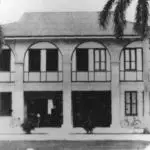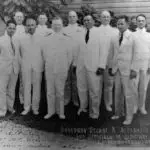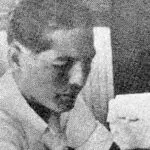US Naval Era: Judges and Island Attorneys



Table of Contents
Share This
View more images for the US Naval Era: Judges and Island Attorneys entry here.
Spanish and Early American
US Naval Governor Edward Dorn replaced all CHamoru/Chamorro justices in 1910 with commissioned officers from the US Navy and Marine Corps. However, by 1918 local judges were back in the island’s courts.
Among these men was Judge Joaquin Cruz Perez, who was acting governor of Guam during the interim between the Spanish and American administrations from 1 February – 20 April 20 1899. He also served as Justice of the Peace in 1894 under Spanish rule, and was later reappointed by the Americans as Associate Justice in 1915.
From 1895 to 1911, Judge Vicente P. Camacho served under both Spanish and American administrations, and was reappointed in 1914. After practicing for 49 years in Guam’s bench, Camacho became the longest serving judge in Guam’s history upon his retirement.
In 1913, the Island Attorney was Tomas Calvo Anderson, who had published an end-of-year report that said he handled 222 complaints. Also listed in the Courts Calendar of this time were Judge Luis de Torres, Junior Judge, and Juan Torres, Chief Clerk of Court in 1913. Manuel E. Sablan was appointed Substitute Judge of the Island Court System in 1914 and later presided over the Police Court. By 1921, Judges A.T. Perez and Jose Roberto had also served.
Post-World War II and Organic Act
After the war ended and life returned to semi-normalcy, the US administration declared emergency martial law and set up the Exception Military Courts to try civilians.
In Justice in Guam, Anthony Sanchez wrote:
The Summary Provost Court was presided over by one Naval officer. This court had jurisdiction over cases punishable with fines of less than one hundred dollars and imprisonment not in excess of one year, or both. The next court in the new system was the Superior Provost Court which consisted of at least one officer. It had jurisdiction over cases with unlimited fines and imprisonment of less than ten years. The Military Commission, the highest court, tried all the more serious crimes.
The courts operated without the benefit of a jury. There was no higher court to appeal a decision, but all cases were reviewed by a higher authority from the Governor’s legal staff. The approval of the Secretary of the Navy was required before execution of criminal case sentences. The Secretary’s review remained in existence only while the military courts were functioning.
In 1946, Judges Camacho, Jose C. Manibusan, and Vicente C. Reyes (who replaced replaced Vicente Camacho who retired in 1947) were the only CHamoru judges serving at that time. In 1950, with the enactment of the Organic Act of Guam that granted the island more control without as much interference from the Executive Branch (Guam’s governors were still appointed by the US President), the Island Court System was again reorganized and named Manibusan, Reyes, and Francisco C. Lujan as the Island Court Judges.
Judges and attorneys today
When the Court Reorganization Act was passed in 1974, Chief Judge of the Island Court, Joaquin Perez, became Presiding Judge over the Superior Court, which was granted jurisdiction over all cases from Guam.
Then in 1996, the Supreme Court of Guam was established as an appellate court, but it was not until the Organic Act was amended about a decade later that the Supreme Court became the highest court in Guam. Prior to this the Supreme Court and Superior Court acted as independent judicial branches.
Judges Peter C. Siguenza, Janet Healy Weeks, and Monessa Lujan were named Chief Justices of the Supreme Court of Guam, followed by Associate Justice and Chief Justice Benjamin J. F. Cruz, former Associate Justice Frances Tydingco-Gatewood, former Chief Justice and presently Associate Justice F. Philip Carbullido, and former Associate Justice and as of 2009 Chief Justice Robert J. Torres.
In 2002, through an act of US Congress, at the petition of local leaders, the voters of Guam were able to elect an attorney general. Prior to this, the sitting governor of Guam had appointment powers. The first elected attorney general (also referred to as Chief Legal Officer) was Douglas B. Moylan who was replaced by Attorney General Alicia Limtiaco. Currently Leevin Taitano Camacho is the Guam Attorney General.
The US President still appoints judges to serve in the District Court of Guam, which handles federal cases. Unlike its mainland counterparts, Guam District Court judges do not serve lifetime appointments. Local judges include Judge Cristobal C. Duenas, Judge John S. Unpingco and current sitting Judge Frances M. Tydingco-Gatewood who was sworn in on 2006.
For further reading
An Act to Approve the Rules of Appellate Procedure for the Supreme Court of Guam and to Amend Subsection (d) of §1103, Title 7, Guam Code Annotated, Relative to the Effective Date of Such Rules. Public Law 23-34. 23rd Guam Legislature, 1995.
Judiciary of Guam. “Judiciary of Guam (Hustisian Guahån).”
Rogers, Robert. Destiny’s Landfall: A History of Guam. Honolulu: University of Hawai’i Press, 1995.
Sanchez, Anthony P. Justice on Guam: A Historical Review. Hagåtña: Superior Court of Guam, 1991.
Sanchez, Pedro C. Guahan Guam: The History of Our Island. Hagåtña: Sanchez Publishing House, 1987.
US Naval Administration of Guam. Guam News Letter 3, no. 2 (August 1911).
–––. Guam News Letter 5, no. 4 (October 1913).
